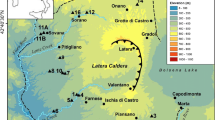Abstract
Coarse, co-ignimbrite lithic breccia, Ebx, occurs at the base of ignimbrite E, the most voluminous and widespread unit of the Kos Plateau Tuff (KPT) in Greece. Similar but generally less coarse-grained basal lithic breccias (Dbx) are also associated with the ignimbrites in the underlying D unit. Ebx shows considerable lateral variations in texture, geometry and contact relationships but is generally less than a few metres thick and comprises lithic clasts that are centimetres to a few metres in diameter in a matrix ranging from fines bearing (F2: 10 wt.%) to fines poor (F2: 0.1 wt.%). Lithic clasts are predominantly vent-derived andesite, although clasts derived locally from the underlying sedimentary formations are also present. There are no proximal exposures of KPT. There is a highly irregular lower erosional contact at the base of ignimbrite E at the closest exposures to the inferred vent, 10–14 km from the centre of the inferred source, but no Ebx was deposited. From 14 to <20 km from source, Ebx is present over a planar erosional contact. At 16 km Ebx is a 3-m-thick, coarse, fines-poor lithic breccia separated from the overlying fines-bearing, pumiceous ignimbrite by a sharp contact. This grades downcurrent into a lithic breccia that comprises a mixture of coarse lithic clasts, pumice and ash, or into a thinner one-clast-thick lithic breccia that grades upward into relatively lithic-poor, pumiceous ignimbrite. Distally, 27 to <36 km from source Ebx is a finer one-clast-thick lithic breccia that overlies a non-erosional base. A downcurrent change from strongly erosional to depositional basal contacts of Ebx dominantly reflects a depletive pyroclastic density current. Initially, the front of the flow was highly energetic and scoured tens of metres into the underlying deposits. Once deposition of the lithic clasts began, local topography influenced the geometry and distribution of Ebx, and in some cases Ebx was deposited only on topographic crests and slopes on the lee-side of ridges. The KPT ignimbrites also contain discontinuous lithic-rich layers within texturally uniform pumiceous ignimbrite. These intra-ignimbrite lithic breccias are finer grained and thinner than the basal lithic breccias and overlie non-erosional basal contacts. The proportion of fine ash within the KPT lithic breccias is heterogeneous and is attributed to a combination of fluidisation within the leading part of the flow, turbulence induced locally by interaction with topography, flushing by steam generated by passage of pyroclastic density currents over and deposition onto wet mud, and to self-fluidisation accompanying the settling of coarse, dense lithic clasts. There are problems in interpreting the KPT lithic breccias as conventional co-ignimbrite lithic breccias. These problems arise in part from the inherent assumption in conventional models that pyroclastic flows are highly concentrated, non-turbulent systems that deposit en masse. The KPT coarse basal lithic breccias are more readily interpreted in terms of aggradation from stratified, waning pyroclastic density currents and from variations in lithic clast supply from source.
Similar content being viewed by others
Author information
Authors and Affiliations
Additional information
Received: 21 April 1997 / Accepted: 4 October 1997
Rights and permissions
About this article
Cite this article
Allen, S., Cas, R. Lateral variations within coarse co-ignimbrite lithic breccias of the Kos Plateau Tuff, Greece. Bull Volcanol 59, 356–377 (1998). https://doi.org/10.1007/s004450050197
Issue Date:
DOI: https://doi.org/10.1007/s004450050197




